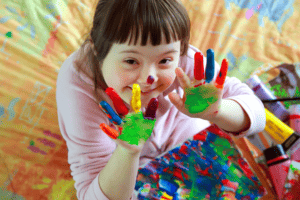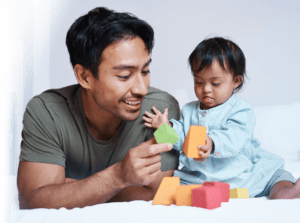Guys, last night I lost it.
My self-regulation skills went out the window. Within the span of 10 minutes, I cleaned up broken glass, burned the kids’ dinner, and saw texts come through about a birthday party I was trying to plan for the next day. Then my youngest decided to do a project on my favorite rug (the one my mom thought I spent too much money on and I probably did but it makes me really happy in our mishmash home)…the project involved GLITTER GLUE. The glitter glue put me over the edge. I feel like you can relate.
Somehow, my version of ‘lost it’ was different than before, though. I really tried to think about what was going on for me and recognize that my stress was coming from many different places. I tried (really hard) to remember I’d rather have the glitter glue on the rug as a sign that my kids are being creative and playing than to have a pristine space. And then I left the house when my husband came home. I took a luxurious (!) trip to the grocery store. Even that mundane errand got me out of the house and gave me the perspective I needed to ground myself again. Because I know that when I’m grounded, my children can be grounded.
(I want to add that I fully appreciate that not everyone has a partner who is available to come home at a given time. It was not always like that for me and it was hard. Really hard. If you are trying to do this all on your own, please ask for help. For help finding local respite or parent support programs, call your local Parent Support Center, or use our Resource Directory if you live in Louisiana or Massachusetts. Also in Spanish.)
We are all dealing with self-regulation. It is a constant work in progress. As parents, we have the added job of thinking about our own self regulation as well as our children’s (and partner’s?!) regulation. I shared the following thoughts a few years back but they are just as relevant to share again today. Enjoy and ask yourself the questions at the end of each point. I hope it gives you a minute to reflect. And also, glitter glue should be an outside toy.
“He has difficulties with self-regulation.” What does that mean?
I’ve been thinking a lot about self-regulation. It is a term I see more and more on IEPs, psychology reports, and in education forums. What is self-regulation and why is it so important?
Dr. Stuart Shanker, in his book Self Reg (2016), cites that the term “self-regulation” is used in hundreds of different ways. He describes self regulation as the “brain-body responses to stress.” In other words, self-regulation is the ability to remain calm when experiencing stress. Stress. Stresses. Stressors. Stressors take many shapes and forms. A stressor might be…
-
when the lights are too bright, or when one bulb flickers every now and then in the corner of the room
-
when you are putting your child on the school bus for the first time
-
when you are getting on the school bus for the first time
-
when you are not sure if there is enough money in the account for the grocery bill
-
when you can’t stop thinking about an itchy tag on your skin
-
when you are entering a playground with fast-moving children yet unsure how to join
-
when your family has experienced a traumatic event, like a storm or accident
We all have stressors. They range from emotional to physical. But how do we deal with these stressors? It is in these moments of stress that we have the opportunity to learn to remain calm and focused; to remain self regulated and move forward. How can we help our children to learn this important skill?
Three “Simple” Steps to Self-Regulation
As you know, being a parent can be stressful. Add to that stress a child that is struggling with self-regulation in the form of tantrums, meltdowns, or aggressive behaviors, and then try to keep your calm. YIKES! This does not sound simple, and it is not. The following three steps help guide me in my self-regulation journey. I hope you find them useful.
Step 1. What Does Your Child Need to be Their Calm Self?
We all have likes and dislikes. Some babies crave car rides to bring them to sleep while others scream endlessly when buckled into the car seat. As we grow and have more experiences, we begin to better identify what helps us find calm. Some of these are universal (we all need to eat and sleep) and some are unique for each of us (some of us love touch or bear hugs and some of us do not).
Question to ask yourself: Can you list 5 things that help your child to find calm? (Remember to really put yourself in your child’s shoes here. This is a list of things that work for your child and their list might be different than yours!)
Step 2. What Do You Need to be Your Calm Self?
I know if I don’t sleep enough, if I don’t exercise, or if I’m distracted emotionally, I am more likely to reach my tipping point sooner. Knowing these things about myself helps me to recognize why I may be feeling or behaving in a certain way. It also helps me to be as regulated as possible by building the things I need into my everyday. When I face stress, as we all do, I seek a walk outside, a minute in my room with the door closed, a sit on my kitchen floor, a text exchange, or conversation with a friend—a hug, time to write, and on and on. These lists will look different for all of us. Read about how getting outside can be powerful for this mom.
Question to ask yourself: What’s on your list? What do you need to regulate yourself?
Step 3. How Can I Help My Child Self-Regulate?
Trying to understand my child’s experience helps me to better understand his behavior. This makes me more likely to express empathy and support instead of frustration and confusion. In other words, this helps me to be more regulated. When I am calm, I can help regulate my son. I can support him by offering what I know he needs to feel calm (see Step 1 above). When my son experiences this feeling of regulation over and over again, he begins to understand what it means to regulate on his own; he begins to understand self-regulation. Not only does he have a model for what regulation looks like, but he has the physical experience of a regulated mind and body.
Questions to ask yourself:
-
Is he physically comfortable? (Are his basic needs met, including diet, sleep, exercise, or a need to go to the bathroom?)
-
Is he feeling emotions that he can’t express? (Is he lashing out because he’s nervous about a new classroom?)
-
Is he facing a challenge that isn’t obvious? (physical or cognitive)
Simple? Not exactly. Worth it? Absolutely.
*Stuart Shanker and his team have developed these useful Self Reg® tools for parents.
Do you know anyone who can relate? Share on social and let’s keep talking!




